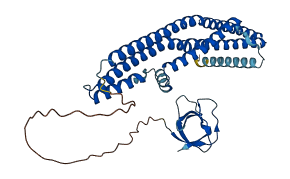| 'de novo' post-translational protein folding |
The process of assisting in the correct noncovalent folding of newly formed polypeptides or folding intermediates of polypeptides that have exited the ribosome and/or have been stabilized and transferred by other chaperone proteins. This process could involve several cycles of ATP hydrolysis. |
| apoptotic process |
A programmed cell death process which begins when a cell receives an internal (e.g. DNA damage) or external signal (e.g. an extracellular death ligand), and proceeds through a series of biochemical events (signaling pathway phase) which trigger an execution phase. The execution phase is the last step of an apoptotic process, and is typically characterized by rounding-up of the cell, retraction of pseudopodes, reduction of cellular volume (pyknosis), chromatin condensation, nuclear fragmentation (karyorrhexis), plasma membrane blebbing and fragmentation of the cell into apoptotic bodies. When the execution phase is completed, the cell has died. |
| autophagic cell death |
A form of programmed cell death that is accompanied by the formation of autophagosomes. Autophagic cell death is characterized by lack of chromatin condensation and massive vacuolization of the cytoplasm, with little or no uptake by phagocytic cells. |
| cellular response to amino acid starvation |
Any process that results in a change in state or activity of a cell (in terms of movement, secretion, enzyme production, gene expression, etc.) as a result of deprivation of amino acids. |
| cellular response to glucose starvation |
Any process that results in a change in state or activity of a cell (in terms of movement, secretion, enzyme production, gene expression, etc.) as a result of deprivation of glucose. |
| membrane fission |
A process that is carried out at the cellular level which results in the separation of a single continuous membrane into two membranes. |
| membrane organization |
A process which results in the assembly, arrangement of constituent parts, or disassembly of a membrane. A membrane is a double layer of lipid molecules that encloses all cells, and, in eukaryotes, many organelles; may be a single or double lipid bilayer; also includes associated proteins. |
| mitochondrion organization |
A process that is carried out at the cellular level which results in the assembly, arrangement of constituent parts, or disassembly of a mitochondrion; includes mitochondrial morphogenesis and distribution, and replication of the mitochondrial genome as well as synthesis of new mitochondrial components. |
| negative regulation of intrinsic apoptotic signaling pathway by p53 class mediator |
Any process that stops, prevents or reduces the frequency, rate or extent of intrinsic apoptotic signaling pathway by p53 class mediator. |
| phosphatidic acid biosynthetic process |
The chemical reactions and pathways resulting in the formation of phosphatidic acid, any derivative of glycerol phosphate in which both the remaining hydroxyl groups of the glycerol moiety are esterified with fatty acids. |
| phospholipid biosynthetic process |
The chemical reactions and pathways resulting in the formation of a phospholipid, a lipid containing phosphoric acid as a mono- or diester. |
| positive regulation of autophagosome assembly |
Any process that activates or increases the frequency, rate or extent of autophagic vacuole assembly. |
| positive regulation of autophagy |
Any process that activates, maintains or increases the rate of autophagy. Autophagy is the process in which cells digest parts of their own cytoplasm. |
| positive regulation of dendrite extension |
Any process that activates or increases the frequency, rate or extent of dendrite extension. |
| positive regulation of dendrite morphogenesis |
Any process that activates or increases the frequency, rate or extent of dendrite morphogenesis. |
| positive regulation of intrinsic apoptotic signaling pathway by p53 class mediator |
Any process that activates or increases the frequency, rate or extent of intrinsic apoptotic signaling pathway by p53 class mediator. |
| positive regulation of membrane tubulation |
Any process that activates or increases the frequency, rate or extent of membrane tubulation. |
| positive regulation of neurotrophin TRK receptor signaling pathway |
Any process that activates or increases the frequency, rate or extent of the neurotrophin TRK receptor signaling pathway. |
| positive regulation of phosphatidylinositol 3-kinase activity |
Any process that activates or increases the frequency, rate or extent of phosphatidylinositol 3-kinase activity. |
| positive regulation of protein insertion into mitochondrial membrane involved in apoptotic signaling pathway |
Any process that activates or increases the frequency, rate or extent of protein insertion into mitochondrial membrane involved in apoptotic signaling pathway. |
| positive regulation of protein-containing complex assembly |
Any process that activates or increases the frequency, rate or extent of protein complex assembly. |
| protein localization to vacuolar membrane |
A process in which a protein is transported to, or maintained in, a location within a vacuolar membrane. |
| receptor catabolic process |
The chemical reactions and pathways resulting in the breakdown of a receptor molecule, a macromolecule that undergoes combination with a hormone, neurotransmitter, drug or intracellular messenger to initiate a change in cell function. |
| regulation of cytokinesis |
Any process that modulates the frequency, rate or extent of the division of the cytoplasm of a cell and its separation into two daughter cells. |
| regulation of early endosome to late endosome transport |
Any process that modulates the frequency, rate or extent of early endosome to late endosome transport. |


